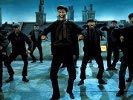Eye For Film >> Movies >> Mary Poppins (1964) Film Review
Mary Poppins
Reviewed by: James Benefield

Forget The Sound Of Music, the real star of Julie Andrews' CV is Mary Poppins. From the opening (mostly) instrumental medley played over a panning shot of the rooftops of London to the (excuse the pun) soaring strains of Let’s Go Fly A Kite closing the film, it is, like the eponymous character, practically perfect in every way. Much imitated (most recently in Nanny McPhee), much parodied (most memorably with Sherry Bobbins in a particularly fine episode of The Simpsons) and even turned into a hit stage show, it’s also been part of popular culture for coming up on 50 years.
The Banks family, residing in London’s exclusive Cherry Tree Lane, are looking for a new nanny to look after their troublesome children Jane and Michael (Karen Dotrice and Michael Garber). However, it’s a difficult job; Edwardian England is a place of change, coming to terms with the campaign for votes for women (as represented by feisty matriarch Mrs Winifred Banks, played by Glynis Johns), yet still clinging on to the prim and proper qualities of Victorian England (the career-oriented, conservative Mr George Banks, played by David Tomlinson). All members of the family have different wants and needs for a nanny, and it’s proving to be a difficult job, as the exit of a nanny at the beginning of the film proves.

An advert in The Times yields a flood of potential employees, however, it’s the children’s advertisement that yields the final result. With both a literal and a metaphorical change in the wind’s direction, Mary Poppins lands on the doorstep of 17, Cherry Tree Lane. She’s authoritative, strong and full of values. She’s also quite magical. Michael, at first glance, asks: "Perhaps it’s a witch?", to which Jane replies: "Of course not. Witches ride brooms."
It’s a film that appeals to children of all ages. Firstly, it is shot through with all kinds of whimsy and imagination - from the tea party on the ceiling, to jumping into paintings, to tidying a nursery through the power of song. It should be ridiculously twee, however, it's also presented in such a straight-faced, matter-of-fact and fully realised way, you never question the film’s reality. Like its eponymous character, the every scene is approached with an intriguing deadpan frivolity that is impossible to resist.
Secondly, its perfectly in tune with its historical context. It is set in the last few years where the British Empire really meant something, yet you can already see the frays around the edges. It’s something chiefly represented by the eccentric yet harmless Admiral Boom (Reginald Owen), whose sounding of the hour with canons on his rooftop-based ship is seen as more of an annoyance than something important and/or necessary. The other chief male characters in the film are also essentially powerless; Tomlinson’s George is not respected by his children or, strictly speaking, by his colleagues. Jack of all trades Bert (Dick Van Dyke) is essentially a man scraping his living whichever way he can, a slave to the wage.
It’s Mary who wears the film’s trousers. The divisions in gender, age and class are transcended Mary Poppins. Despite being clearly very middle class, Mary Poppins is seemingly best friends with Burt (Dick Van Dyke, complete with infamously dodgy mockney accent). She visits the elderly, gains the affection of the Banks’ servants and communicates with animals. And she does it with wit, panache and, above all, dignity. She’s all powerful and all knowing, yet manages to keep her femininity throughout, looking eternally radiant and elegant.
Aside from the thematic richness of the film, it’s also great fun. It features some of the best songs to appear in any Disney film: A Spoonful Of Sugar, Feed The Birds, Chim Chim Cher-ee and, of course, Supercalifragilisticexpialidocious. It won an Oscar for its visual effects (the stunning melding of live action and animation in the sequence where Mary and the children jump into the drawing in the park). It is also full of fantastic set pieces, such as the chimney sweep dance, the fox hunt which turns into a horse race and the ruckus the children make at the bank, causing much financial chaos, to name but three.
There are great debates about what the best children’s film of all time is, but Mary Poppins surely has to be a strong contender. Intelligent, well-acted, supremely entertaining and visually sumptuous, it’s a staple for any serious film fan’s DVD collection. And Julie Andrews, in an Oscar-winning performance, is simply wonderful. It’s a film that reminds me of Christmas; the whole family can sit down to watch it, enjoy themselves and do it all over again the next festive season. And the next. And the next.
Reviewed on: 04 Apr 2009

















